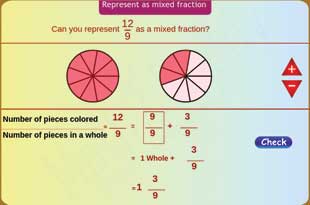Kannan Bharadwaj
Technology has gained a new prominence in the wake of the COVID-19 pandemic. It is not just office goers who are working from home but students are learning from home as well. In these highly uncertain times, schools are exploring digital ways of bringing learning to students in their homes. Technology is slowly transforming from being a supplemental resource to becoming an integral part of education. This article examines some advantages of technology, especially in math education, and the changes required in the school ecosystem to ensure that it is impactful.
Math is a subject that is best learnt through exploration. It is proven that hands-on exploratory learning is very effective in helping children grasp concepts, especially at the primary level. Towards this end, most math textbooks have changed to include more activities, thereby making math learning interesting and easy to relate to everyday life.
 Unfortunately, most schools teach mathematics in a procedural way. We teach students ways and methods to find solutions to problems and students just follow the steps as outlined by the teacher to arrive at the answers. There is no clarity on what exactly happens when we follow these steps. To a large extent, hands-on activities help students explore and find out what exactly happens when we follow those steps. With hands-on instruments, concepts such as the number system, fractions, decimals, operations and geometry can be modelled and internalized with so much ease. Even in higher classes, integers and algebra including polynomial operations, factorization, etc., can be understood a lot more easily with hands-on instruments such as algebra tiles.
Unfortunately, most schools teach mathematics in a procedural way. We teach students ways and methods to find solutions to problems and students just follow the steps as outlined by the teacher to arrive at the answers. There is no clarity on what exactly happens when we follow these steps. To a large extent, hands-on activities help students explore and find out what exactly happens when we follow those steps. With hands-on instruments, concepts such as the number system, fractions, decimals, operations and geometry can be modelled and internalized with so much ease. Even in higher classes, integers and algebra including polynomial operations, factorization, etc., can be understood a lot more easily with hands-on instruments such as algebra tiles.
However, when we get to the higher classes, there are so many concepts and theorems that students just learn by rote due to lack of tools to help them visualize and understand. Here is where technology can help teachers illustrate concepts in the classroom and students learn with understanding. With the advances in technology over the last two decades, there is so much that can be done in leveraging technology to make math teaching and learning more effective.
Learning with understanding
Technology can bring abstract math concepts to life, be it through visual illustrations or through videos. Every theorem in geometry can be visualized and understood better with the help of technology. Students do not need to learn by rote why the sine of an angle is positive in the first and second quadrants and negative in the third and fourth quadrants. They can actually see it in action and understand why this is the case. There are freely available tools such as GeoGebra that allow a teacher to bring many of these concepts to life with a little bit of effort. There are also paid tools like Math Buddy which provide curriculum aligned ready-to-use simulations that the teacher can use to help children visualize and understand math concepts.
Even in lower classes, while hands-on learning is very powerful in understanding concepts, technology can play an important role in reinforcing concepts. Bringing in a CPA approach (Concrete, Pictorial, Abstract) into our instruction can provide lots of benefits since we are able to cater to all types of learning styles – visual, auditory and kinesthetic.
Another big advantage of a digital component is the ability to provide personalized learning. In a typical classroom of 30-40 students, it is very difficult for teachers to provide personalized attention to every student. This, combined with the pressure to finish the curriculum, pushes teachers to take a ‘one size fits all’ approach in their instructional strategies. Technology tools can help assess individual student needs and provide feedback to the teachers on how much the students have understood the lecture, which can help teachers tremendously to improve their instructional strategies.

Technology has also enabled many educators to adopt alternative instructional strategies such as flipped classrooms which can be invaluable in moving the focus away from “teaching” to “learning”. The learning happens outside of the classrooms and a typical classroom session is transformed into more of a discussion session between the students and the teacher. There are also benefits of peer learning with the teachers playing the role of facilitators in the learning process.
Math is one subject, where in addition to understanding, practice plays a key role in helping students master problem solving skills. Technology can be harnessed in very productive ways to help students practice solving various types of problems customized to each student’s needs. The programs can adapt to the level of the student and help them move up mastering increasingly difficult questions. In addition, technology can help in keeping this practice interesting and engaging for students through gamification. There are various resources available that tap into children’s interest in playing games on their computer or mobile devices by gamifying learning environments.
Communication and collaboration
While the tools described above are content-specific tools which help educators deal specifically with subject related content, there are also numerous content neutral tools that play a significant role in education in the times of a pandemic. These are primarily communication and collaboration tools such as Google Classroom and WhatsApp, which are slowly becoming an integral part of many schools. In fact, tools such as WhatsApp have played a stellar role in educators extending education beyond the four walls of a classroom and being available for students anytime, anywhere.
With the availability of smartphones in every household, data being available in plenty at almost no cost and vast improvements in streaming tools, teachers can teach from anywhere and impact not only the students in their classrooms, but millions of students in any corner of the world. Students do not have to fret over not understanding a particular concept, as a simple Google search will throw up hundreds of resources from various teachers. In fact, free resources such as Khan Academy provide students with high quality visual explanations of many concepts and have become a great leveller in making education available and accessible to every student across the world.
Another important role technology can play is to enable teachers to measure students’ level of understanding in the classroom in a non-threatening way. For example, technology devices such as Classroom Clickers are used extensively in some countries where students answer questions without the fear of being shamed and teachers get a clear idea of the level of understanding of the students. Technology also can provide an environment conducive to discussions and collaboration, which is essential for understanding abstract concepts.

Teacher training and continuous learning
While it is wonderful to have so many resources for students beyond the classrooms to help them understand concepts, it also means that teachers have to keep learning to ensure that they are up to date with various techniques to teach a particular topic. With teachers being responsible for many other duties in a typical school other than teaching, most find it difficult to find time to keep themselves updated and relevant. This can cause a great deal of harm in the long run where students begin to think they know better and start disregarding the teacher.
Teachers must earn to accept how technology can enhance students’ learning and take steps to integrate technology into their day-to-day teaching. Schools must also take steps to not only organize many sessions with experts who can guide the teachers, but also ensure that teachers have access to the necessary hardware with software applications and web resources. There needs to be a lot of investment in training teachers in the usage of technology tools and helping them get comfortable enough to start using them in their classrooms.
Therefore, it is imperative that schools set aside time for teachers to learn, be it keeping themselves up to date with technology or sound pedagogical techniques to help students learn better. There needs to be a lot of emphasis on teacher education and professional development to continually update teachers’ technological capabilities and resources to support teaching and learning. In addition to training in use of technology, teachers need to be trained continuously in their specific subjects and how they can take advantage of technology and integrate digital tools in daily instruction.
Education policy changes
Lastly, the advantages of technology described above can be derived only from systemic changes in our education system. One of the most important changes required is to move away from testing the students’ rote learning capability and start testing their concept understanding. Our curriculum needs to emphasize activities and exploration which will help students get a clear understanding of what they are learning. We need to change from a system where we spoon feed all the information to one which encourages them to explore and learn things on their own. The focus has to change from “teaching” to “learning” where the teachers play the role of facilitators and help students in their path of discovery and technology can play a stellar role in making this happen.
The author is the Co-Founder & CEO of Math Buddy (www.mathbuddyonline.com), a company focused on providing tools to help teachers teach concepts and for students to learn with understanding. He can be reached at kannan@mathbuddyonline.com.
